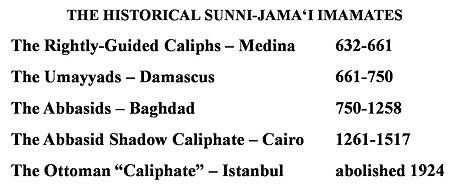Image Resource Bank
Image Gallery |  6 of 15
6 of 15 
Historical Evolution of the Sunnī-Jamā‘ī Imamate
This chart identifies major phases and transition points, but it is more appropriate to see the evolution of the Sunnī-Jamā‘ī Imamate as fluid and gradual rather than segmented and abrupt. The political history of Islamic civilization begins with the emergence of the utopian Medinan ummah, the ideal Muslim society led by the Prophet Muhammad in which divine and earthly authority perfectly coincide. The utopian Medinan ummah terminated with the death of the Prophet, and his successors maintained the ummah’s integritythrough the first elaboration of the Sunnī-Jamā‘ī Imamate. As the Muslim community expanded, the Sunnī-Jamā‘ī Imamate became the central governing institution of a large, agrarian land empire, in which religious and state authority were theoretically located in the personage of the caliph-imām, but he exercised his authority through a complex network of ministers, military commanders, and judges. As this empire fractured, sacral kings (sultāns) displaced the caliph-imāms as immediate political rulers, but the Sunnī-Jamā‘ī Imamate continued as a parallel domain of religious authority. In the final phase considered in this module – following the Mongol conquests and the termination of the Abbasid line of caliph-imāms – a version of the Sunnī-Jamā‘ī Imamate reappeared, but it was entirely subsumed within the Ottoman system of rulership and justice.
Name: Historical Evolution of the Sunnī-Jamā‘ī Imamate
Material: JPEG image
Size: 1498 x 596 pixels
Date: 2009
Place of Origin: University of Chicago
Location: Chicago, IL
Source and Registration#: Professor John E. Woods

 John Woods
John Woods
Professor of Iranian and Central Asian History, and of Near Eastern Languages & Civilizations
 Alexander Barna
Alexander Barna
Outreach Coordinator, Center for Middle Eastern Studies, University of Chicago




